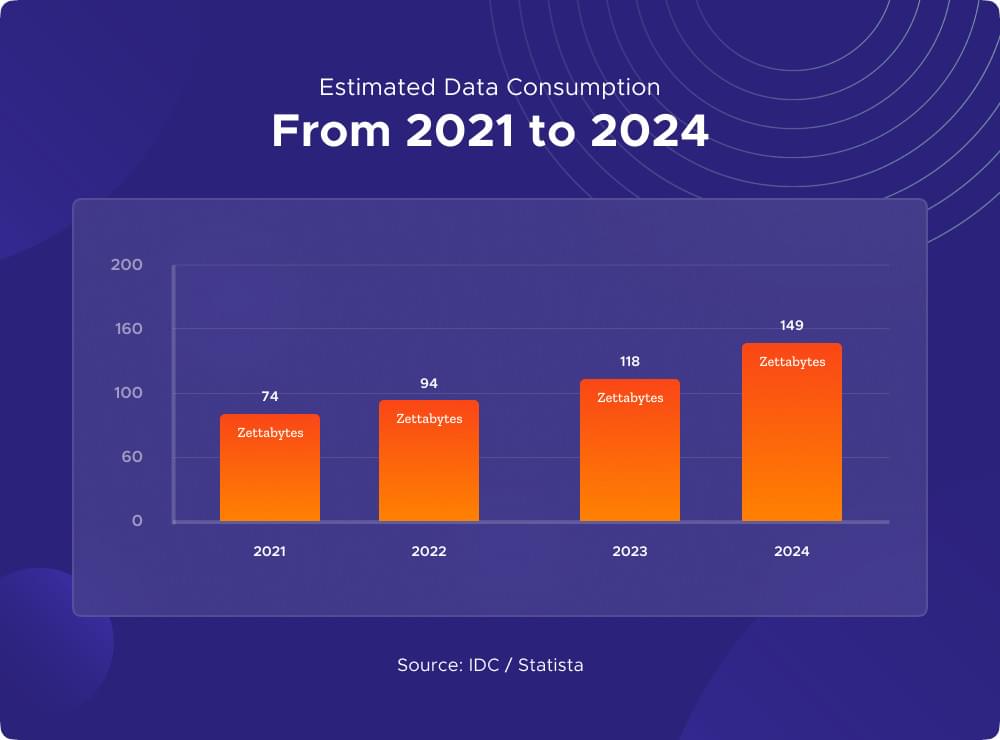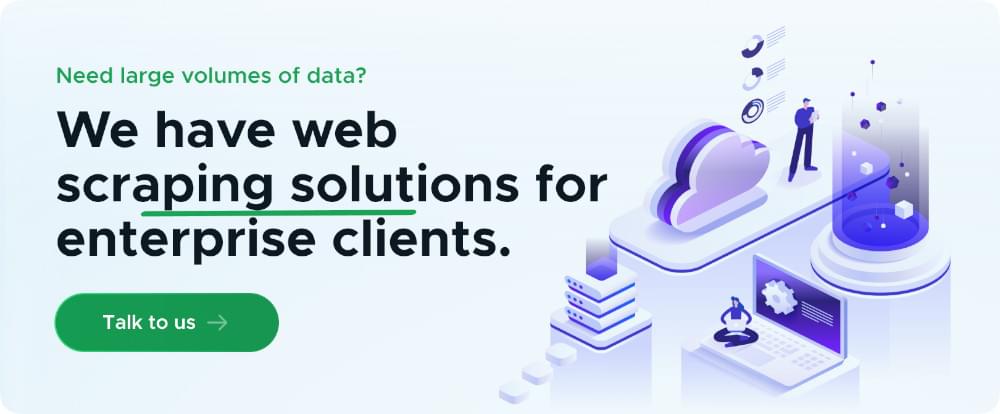Gathering and analyzing large amounts of data in the finance industry is important as this industry thrives on data-driven decision-making. The industry uses this vast amount of information to stay competitive and make informed decisions. Financial institutions can access real-time data from various online sources by implying large-scale web scraping to gain valuable insights and drive their business forward.
As estimated in 2024, the data consumption in finance industry is likely to increase. The finance industry relies heavily on timely and accurate data to make investment decisions, monitor market trends, analyze company performance, and much more. Traditionally, financial institutions have relied on manual data-gathering methods, which are not only time-consuming but also prone to errors. Large-scale web scraping offers a more efficient and reliable solution, enabling financial organizations to gather vast amounts of data from multiple online sources in real-time, by analyzing this data.

Importance of Large volume data in finance
In the fast-paced world of finance, data plays a crucial role in driving decision-making and ensuring businesses stay ahead of the competition. Businesses must understand the importance of large-volume data in finance and how it can provide invaluable insights and a competitive edge. The sheer volume of data available today is staggering, and extracting meaningful insights from this wealth of information can be daunting.
Financial data encompasses various information, including financial statements, market trends, customer behavior, etc. Businesses can identify patterns, spot potential risks, and formulate data-driven strategies by analyzing this data. Extracting and analyzing large volumes of data is essential for financial institutions, investment firms, and businesses looking to make informed decisions.
Benefits of Large-Scale Web Scraping for Finance
- Real-Time Data: Financial institutions can access real-time data from various online sources with large-scale web scraping. This allows them to stay up-to-date with market trends, news, and events that can impact their investment decisions.
- Efficiency: Manual data-gathering methods are labor-intensive and error-prone. Web scraping automates the data collection process, saving time and reducing the risk of human error.
- Risk Management: Web scraping allows financial institutions to monitor and analyze data related to risk factors such as market volatility, regulatory changes, and economic indicators. This enables them to manage risks and make informed decisions proactively.
- Cost-Effective: Large-scale web scraping eliminates the need for manual data gathering, which can be costly and time-consuming. Financial institutions can save time and resources by automating the process of web scraping with web scraping tools.
Implementing Large-Scale Web Scraping for Finance
Implementing large-scale web scraping for finance requires careful planning and consideration. Here are the critical steps involved in the process:
1. Define the Scope
The first step is to define the scope and objectives. Determine the specific data you need to gather, the online sources you want to scrape, and the frequency at which you need the data updated.
2. Identify Reliable Data Sources
Identify the online sources that provide the data you need for your finance-related analysis. This could include financial news websites, stock exchanges, regulatory websites, and other relevant sources. Ensure that your sources are reliable and provide the data in a structured format.
3. Choose the Right Tools and Technologies
Selecting the right web scraping tools and technologies is crucial for a successful large-scale project. Consider factors such as scalability, ease of use, data extraction capabilities, and compatibility with your existing systems.
4. Develop the Scraping Code
Once you have defined the scope, identified the data sources, and chosen the tools, it’s time to develop the scraping code. Depending on your requirements, you may need to write custom code or use existing libraries and frameworks for web scraping.
5. Handle Data Extraction Challenges
Web scraping can present challenges, such as handling dynamic web pages, CAPTCHA, and IP blocking. It’s essential to have strategies in place to overcome these challenges and ensure a smooth data extraction process.
6. Clean and Validate the Data
After extracting the data, cleaning and validating it is crucial to ensure its accuracy and integrity. This involves removing duplicates, handling missing values, standardizing data formats, and verifying the data against predefined rules and criteria.
7. Analyze the Data
After validating the data, analyze it. Analyzing large-volume financial data involves applying various statistical and analytical techniques to identify patterns, relationships, and anomalies. One common approach to analyzing large volumes of financial data is through data visualization. Businesses can quickly identify trends, outliers, and correlations by creating visual representations of the data, such as charts, graphs, and dashboards. AI charts for presentations can help generate dynamic, data-driven visuals that make your financial analysis clearer and more impactful. Another approach to analysis is predictive modeling. Through historical data and statistical algorithms, businesses can develop models that predict future trends and outcomes. These predictive models can help businesses make informed decisions and anticipate potential risks or opportunities.
8. Store the Data
Once the data is cleaned and validated, it must be stored in a structured format for further analysis. Consider using a database or data warehouse to store the data securely. You can then use data analysis tools and techniques to gain insights and make informed decisions.
Best Practices for Large-Scale Web Scraping in Finance
To ensure the success of your large-scale web scraping project in the finance industry, consider the following best practices:
- Respect Website Policies: Before scraping a website, review its terms of service and ensure you comply with its policies and guidelines.
- Use Proxies and IP Rotation: To avoid IP blocking and ensure a smooth scraping process, consider proxies and rotating IP addresses.
- Monitor Data Quality: Regularly monitor the quality of the scraped data to identify any anomalies or inconsistencies. Implement data validation checks to ensure the accuracy and integrity of the data.
- Implement Rate Limiting: To avoid overloading websites and maintain good scraping etiquette, implement rate limiting by adding delays between requests. It’s hard to do so with manual data extraction processes therefore, the best choice is to go for a web scraper that offers enterprise solutions like Crawlbase.
Case Studies: Large-Scale Web Scraping in Finance
Case Study 1: Investment Research
A leading investment firm used large-scale web scraping to gather real-time financial data from various online sources. By automating the data collection process, they could access vast data and analyze it to identify investment opportunities, monitor market trends, and make informed decisions.
Case Study 2: Risk Management
A multinational bank implemented large-scale web scraping to monitor and analyze data related to market volatility, regulatory changes, and economic indicators. By gathering real-time data from multiple sources, they could proactively manage risks, adjust their investment strategies, and comply with regulatory requirements.
Utilizing APIs for Large-Scale finance data extraction
In the context of data extraction for large volumes of data for finance, APIs enable businesses to access and extract valuable information from financial databases, e-commerce, market feeds, and other platforms.
To utilize APIs effectively, businesses must first understand how they work and the data they can provide. APIs typically have specific endpoints that allow users to retrieve specific data sets or perform certain actions. For example, a financial API may provide endpoints to access stock prices, historical financial data, or even real-time market data. By understanding the available endpoints and the data they provide, businesses can extract and utilize the information they need for analysis and decision-making.
Crawlbase Crawling API provides an enterprise solution to scrape massive amounts of data. Be it large-scale web scraping for e-commerce or finance, its enterprise solution has got you covered.
Conclusion
I hope this article helped you understand large-scale web scraping for finance and suggested the tools to consider for scraping finance sites on a large scale.
If you’re new to scraping large volumes of data, here are some useful links.
E-commerce Large-Scale Web Scraping
If you need help scraping large volumes of data, feel free to contact our support team or visit our enterprise page for more information.











